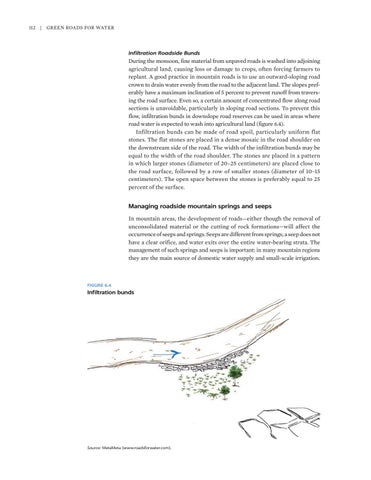112 | Green Roads for Water
Infiltration Roadside Bunds
During the monsoon, fine material from unpaved roads is washed into adjoining agricultural land, causing loss or damage to crops, often forcing farmers to replant. A good practice in mountain roads is to use an outward-sloping road crown to drain water evenly from the road to the adjacent land. The slopes preferably have a maximum inclination of 5 percent to prevent runoff from traversing the road surface. Even so, a certain amount of concentrated flow along road sections is unavoidable, particularly in sloping road sections. To prevent this flow, infiltration bunds in downslope road reserves can be used in areas where road water is expected to wash into agricultural land (figure 6.4). Infiltration bunds can be made of road spoil, particularly uniform flat stones. The flat stones are placed in a dense mosaic in the road shoulder on the downstream side of the road. The width of the infiltration bunds may be equal to the width of the road shoulder. The stones are placed in a pattern in which larger stones (diameter of 20–25 centimeters) are placed close to the road surface, followed by a row of smaller stones (diameter of 10–15 centimeters). The open space between the stones is preferably equal to 25 percent of the surface.
Managing roadside mountain springs and seeps In mountain areas, the development of roads—either though the removal of unconsolidated material or the cutting of rock formations—will affect the occurrence of seeps and springs. Seeps are different from springs; a seep does not have a clear orifice, and water exits over the entire water-bearing strata. The management of such springs and seeps is important: in many mountain regions they are the main source of domestic water supply and small-scale irrigation.
FIGURE 6.4
Infiltration bunds
Source: MetaMeta (www.roadsforwater.com).







































